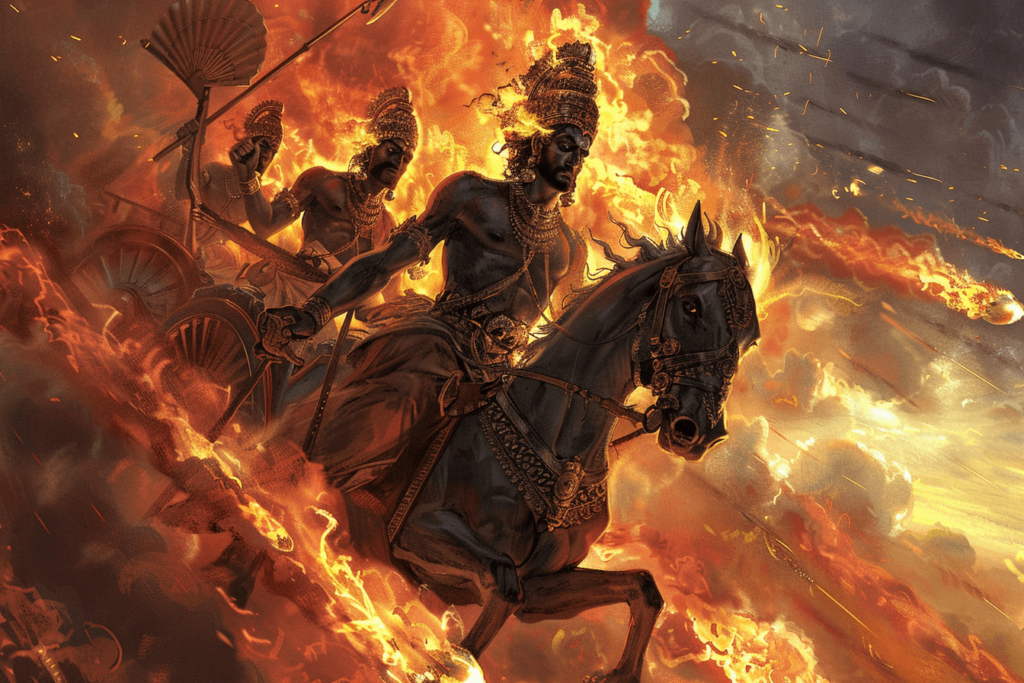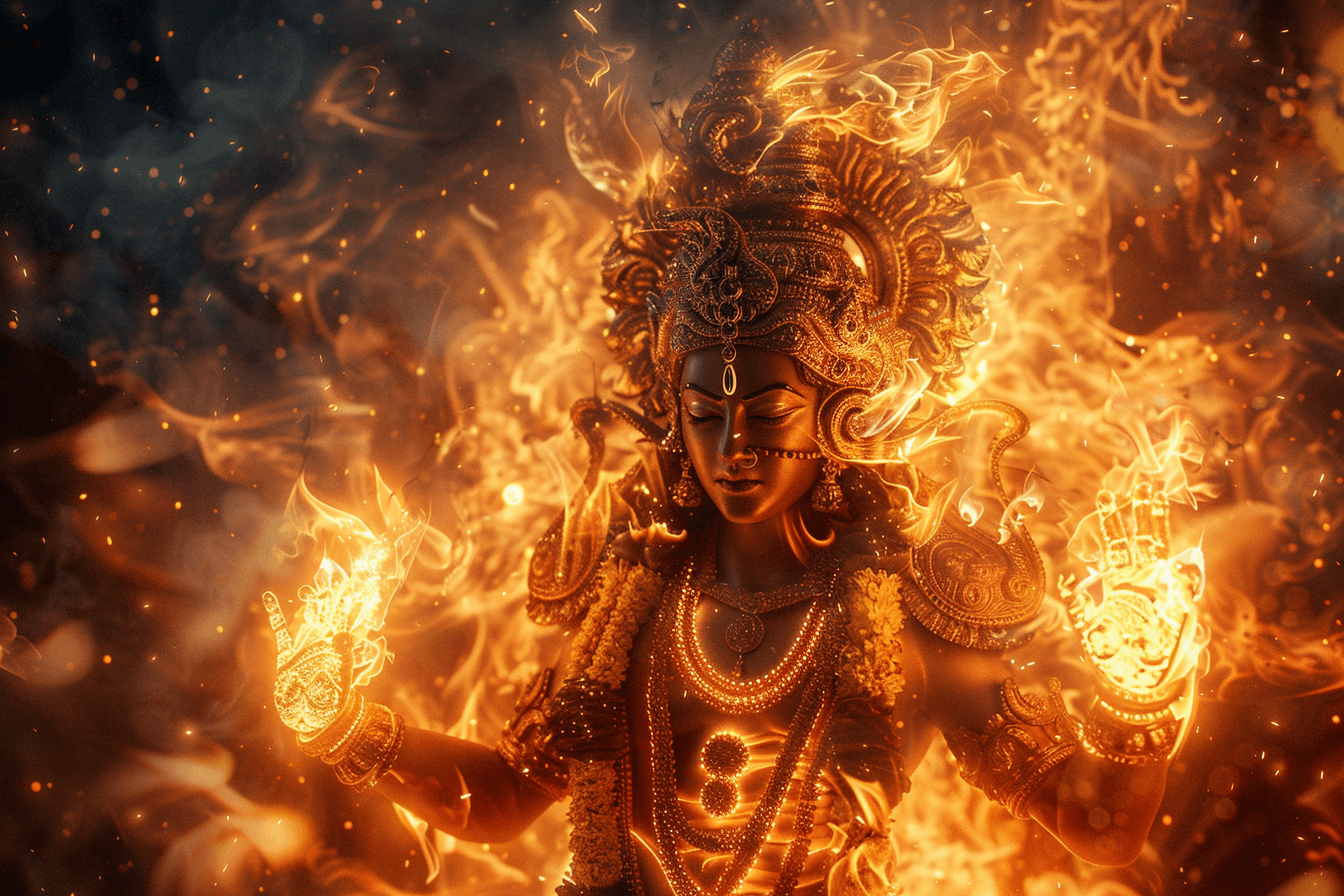When we talk about the Hindu pantheon, one name that stands out is Agnidev, the god of fire. Agni, as he’s often called, plays a vital role in Hindu mythology and rituals. From sacrificial fires to the flames of a domestic hearth, Agni is everywhere. Let’s delve into the captivating world of Agnidev and understand his importance in Hindu culture.
The Many Faces of Agni
Agni isn’t just about the fire we see every day. He’s associated with various forms of fire, including:
- The Sun: The ultimate source of light and heat.
- Lightning: A powerful, natural force.
- Comets: Celestial fireballs streaking across the sky.
- Sacrificial Fire: Central to Vedic rituals.
- Domestic Fires: The heart of every home.
- Funeral Pyres: Guiding souls to the afterlife.
- Digestive Fire: The inner energy within all living beings.
During the Vedic period (1500-500 BCE), Agni was one of the most revered deities, and the Vedas contain more hymns dedicated to him than to any other god. Even today, though not directly worshipped as much, Agni is omnipresent in various Hindu ceremonies, especially marriages and other significant rites of passage.
Agni’s Mythical Tales
Agni’s mythology is rich and varied. He is known to be the son of the Celestial Waters, symbolizing the connection between water and fire. When it rains, the fire is believed to descend to earth, only to rise again through vegetation. This cycle is a beautiful representation of the balance in nature.
One of the fascinating tales involves Agni’s reluctance to take on the duty of carrying offerings to the gods, fearing the same fate as his three brothers who perished while performing the task. To escape this duty, Agni hid in various places but was eventually discovered each time by different creatures. His final refuge, a sami tree, became sacred in Hindu rituals, with its sticks used to kindle fires. Despite his initial reluctance, Agni negotiated to receive a share of the sacrifices and was granted everlasting life.

Agni in Hindu Art
In Hindu art, Agni is depicted in various forms:
- Appearance: Agni often has black skin, two heads, four arms, and rides a goat or a chariot drawn by red horses. His two heads represent the domestic and sacrificial fires.
- Symbols: He carries a fan, a sacrificial ladle, an axe, and a flaming torch or javelin.
- Depictions: Sometimes shown as the Garuda bird or a goat-headed merchant, representing his role in sacrifices.
Agni’s artistic representations are not just symbolic but also a way to visualize his multifaceted nature.
Agni’s Role in Rituals and Daily Life
Agni’s presence is essential in many Hindu rituals. As a mediator between gods and humans, he carries offerings to the deities and brings their blessings to the worshippers. His role is so crucial that no significant Hindu ceremony, be it a wedding or a funeral, is complete without invoking Agni.
Agni is also considered the guardian of the southeast direction in Hindu cosmology, protecting this space as one of the eight guardians of directions (Dikpalas).
The Legacy of Agni
Over time, Agni’s prominence as a god has waned somewhat, but his legacy endures. His significance is captured beautifully in various Hindu scriptures, including the Mahabharata, the Vishnu Purana, and the Agni Purana. Agni’s tales, from his mythical origins to his role in epic battles and ceremonies, continue to inspire and fascinate.
Even today, the worship of Agni promises prosperity, protection, and a long life. Offering food and sacrifices to Agni ensures his blessings, safeguarding homes and families. The Agni Puran remains a vital source of these traditions, emphasizing Agni’s role and importance in rituals and daily life.
The Everlasting Flame of Agni
Agni, the Hindu god of fire, remains a powerful symbol of transformation, purification, and connection between the divine and the earthly. His presence in rituals underscores the importance of fire in Hindu culture, symbolizing life, death, and rebirth. As we light a fire, be it in a ritual or a simple hearth, we are reminded of Agni’s enduring presence and his vital role in the tapestry of Hindu mythology.
Frequently Asked Questions
1. What is Agni the god of ?
Agni is the Hindu god of fire. He is one of the most important deities in Vedic traditions and is revered as the fire god who plays a vital role in various ceremonies and rituals.
2. Why do Hindus pray to Agni?
Hindus pray to Agni for several reasons:
- Mediator: Agni is considered the mediator between humans and gods. Through fire rituals (yajnas), prayers, and offerings, Agni carries the offerings to the gods.
- Purification: Fire is seen as a purifying element. Praying to Agni is believed to purify the mind, body, and spirit.
- Blessings and Protection: Devotees seek Agni’s blessings for prosperity, protection, and well-being.
- Sacred Rituals: Agni is central to many Hindu rituals and ceremonies, such as marriages, funerals, and other sacred rites.
3. Is Agni male or female?
Agni is traditionally depicted as a male deity in Hindu mythology.
4. What are Agni’s powers?
Agni’s powers include:
- Conveyor of Sacrifices: He conveys the offerings made in fire rituals to the gods.
- Purifier: Agni has the power to purify everything he touches.
- Sustainer of Life: Fire is essential for cooking, warmth, and various human activities, making Agni a sustainer of life.
- Illuminator: Agni provides light and dispels darkness, symbolizing knowledge and wisdom.
5. Who is Agni’s wife?
Agni’s wife is generally recognized as Svaha. In Hindu mythology, Svaha is the personification of the sacrificial offering and is associated with the invocation of gods during rituals.




